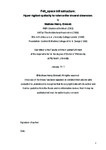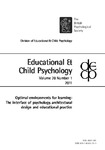Felt_space infrastructure: Hyper vigilant spatiality to valence the visceral dimension
| dc.contributor.supervisor | Woolner, Martin | |
| dc.contributor.author | Emmett, Mathew Henry | |
| dc.contributor.other | Faculty of Arts, Humanities and Business | en_US |
| dc.date.accessioned | 2013-06-07T08:36:42Z | |
| dc.date.available | 2013-06-07T08:36:42Z | |
| dc.date.issued | 2013 | |
| dc.identifier | 230815 | en_US |
| dc.identifier.uri | http://hdl.handle.net/10026.1/1495 | |
| dc.description.abstract |
Felt_space infrastructure: Hypervigilant spatiality to valence the visceral dimension. This thesis evolves perception as a hypothesis to reframe architectural praxis negotiated through agent-situation interaction. The research questions the geometric principles of architectural ordination to originate the ‘felt_space infrastructure’, a relational system of measurement concerned with the role of perception in mediating sensory space and the cognised environment. The methodological model for this research fuses perception and environmental stimuli, into a consistent generative process that penetrates the inner essence of space, to reveal the visceral parameter. These concepts are applied to develop a ‘coefficient of affordance’ typology, ‘hypervigilant’ tool set, and ‘cognitive_tope’ design methodology. Thus, by extending the architectural platform to consider perception as a design parameter, the thesis interprets the ‘inference schema’ as an instructional model to coordinate the acquisition of spatial reality through tensional and counter-tensional feedback dynamics. Three site-responsive case studies are used to advance the thesis. The first case study is descriptive and develops a typology of situated cognition to extend the ‘granularity’ of perceptual sensitisation (i.e. a fine-grained means of perceiving space). The second project is relational and questions how mapping can coordinate perceptual, cognitive and associative attention, as a ‘multi-webbed vector field’ comprised of attractors and deformations within a viewer-centred gravitational space. The third case study is causal, and demonstrates how a transactional-biased schema can generate, amplify and attenuate perceptual misalignment, thus triggering a visceral niche. The significance of the research is that it progresses generative perception as an additional variable for spatial practice, and promotes transactional methodologies to gain enhanced modes of spatial acuity to extend the repertoire of architectural practice. | en_US |
| dc.language.iso | en | en_US |
| dc.publisher | University of Plymouth | en_US |
| dc.subject | felt_space infrastructure | en_US |
| dc.subject | Perception | en_US |
| dc.subject | Visceral space | en_US |
| dc.subject | Coefficient of affordance | en_US |
| dc.subject | Cognitive_tope mapping | en_US |
| dc.subject | Inference schema | en_US |
| dc.subject | Site-responsive | en_US |
| dc.subject | Situated cognition | en_US |
| dc.subject | Affect | en_US |
| dc.subject | Field | en_US |
| dc.subject | Architecture | en_US |
| dc.subject | Transactional methodologies | en_US |
| dc.subject | Space | en_US |
| dc.subject | Mnemonic site | en_US |
| dc.subject | Multimodal feedback | en_US |
| dc.subject | Hyper vigilant spatiality | en_US |
| dc.subject | Ordination | en_US |
| dc.subject | Sensory editing | en_US |
| dc.subject | Recursive durations | en_US |
| dc.subject | Trigger event | en_US |
| dc.subject | Space - body temporality | en_US |
| dc.subject | Raumfindung | en_US |
| dc.subject | Mobius manifold | en_US |
| dc.subject | Space taxonomy | en_US |
| dc.title | Felt_space infrastructure: Hyper vigilant spatiality to valence the visceral dimension | en_US |
| dc.type | Thesis | |
| plymouth.version | Full version | en_US |
| dc.identifier.doi | http://dx.doi.org/10.24382/3227 |
Files in this item
This item appears in the following Collection(s)
-
01 Research Theses Main Collection
Research Theses Main



